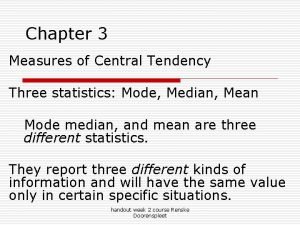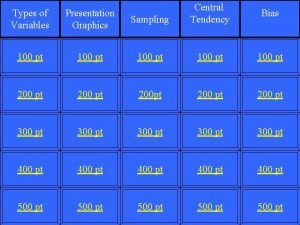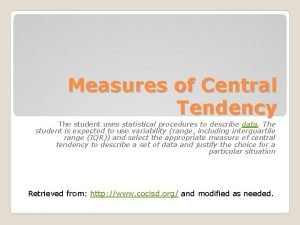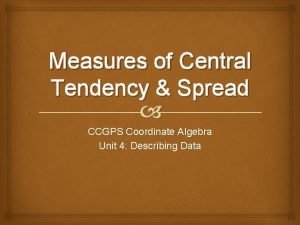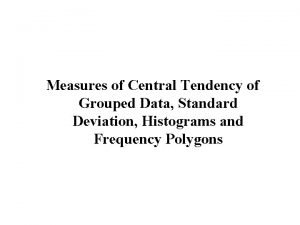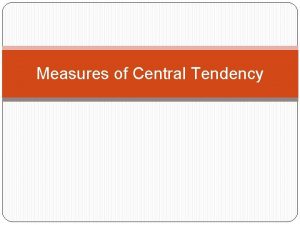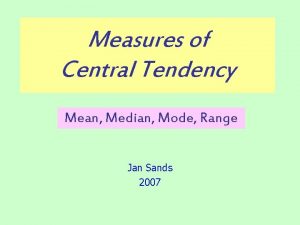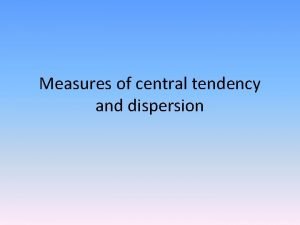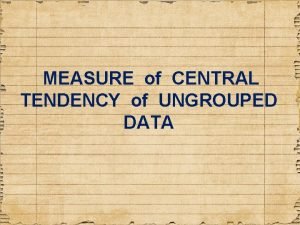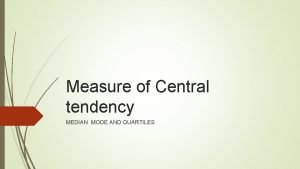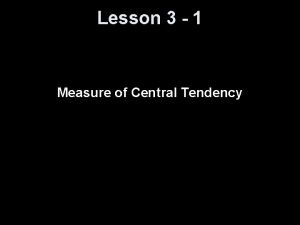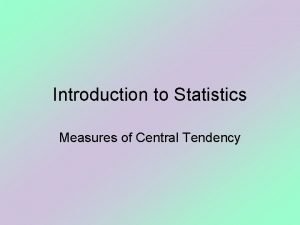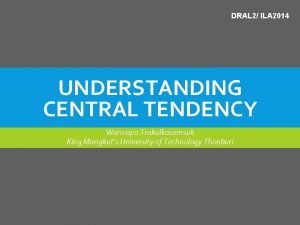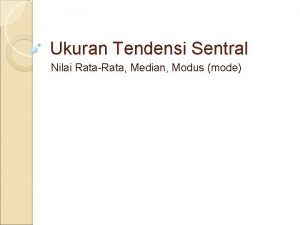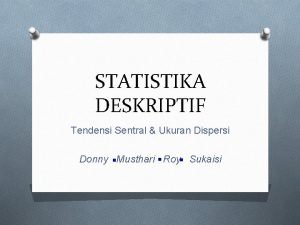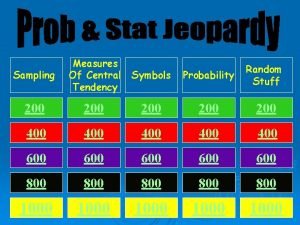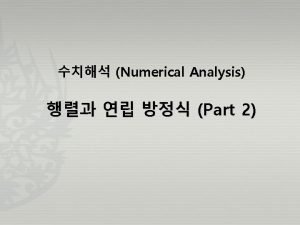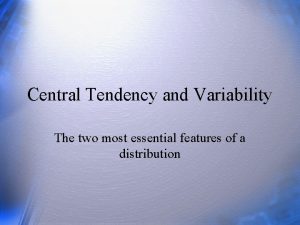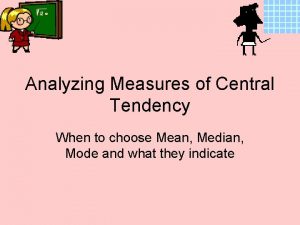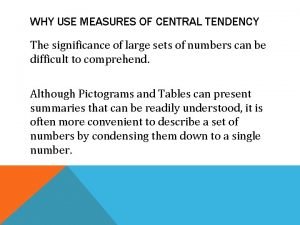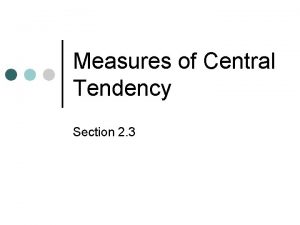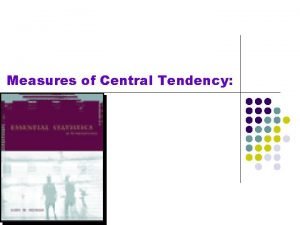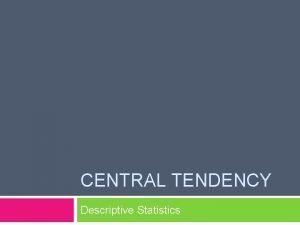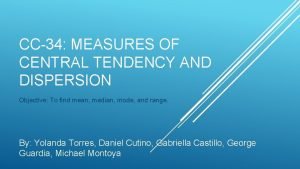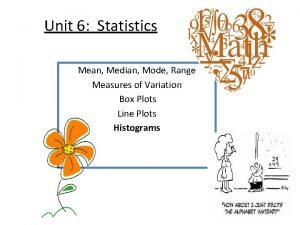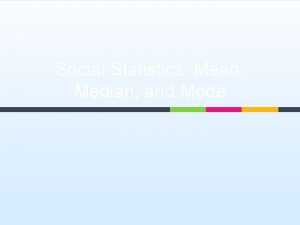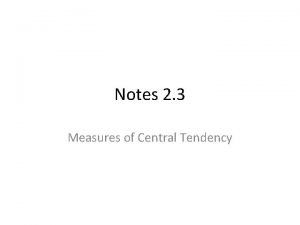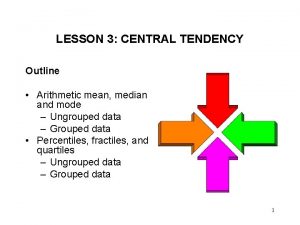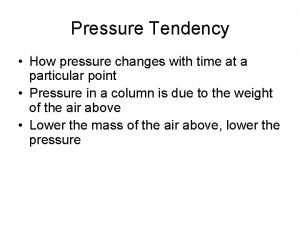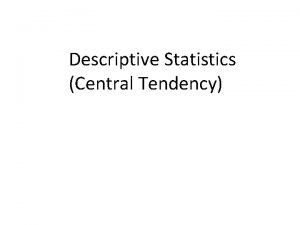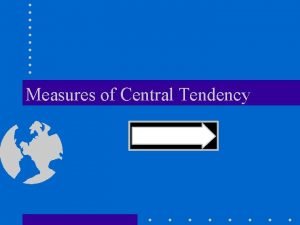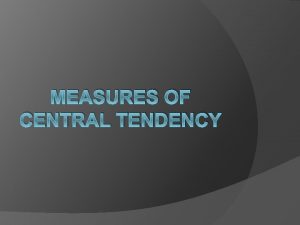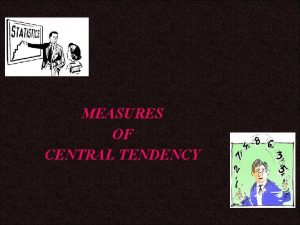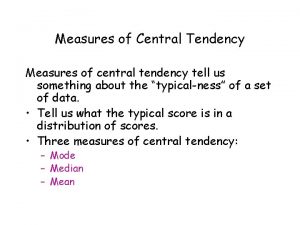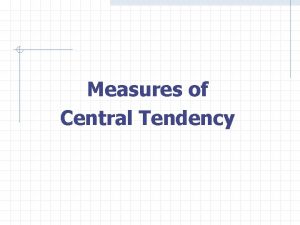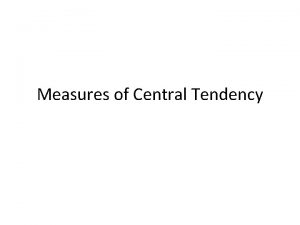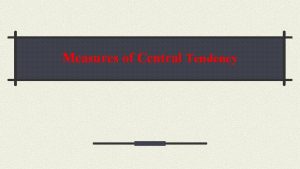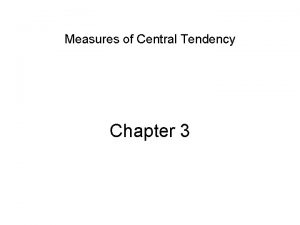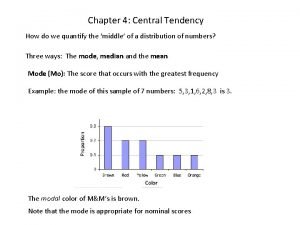Chapter 3 Central Tendency Central Tendency In general













































- Slides: 45

Chapter 3: Central Tendency

Central Tendency • In general terms, central tendency is a statistical measure that determines a single value that accurately describes the center of the distribution and represents the entire distribution of scores. • The goal of central tendency is to identify the single value that is the best representative for the entire set of data.

Central Tendency (cont'd. ) • By identifying the "average score, " central tendency allows researchers to summarize or condense a large set of data into a single value. • Thus, central tendency serves as a descriptive statistic because it allows researchers to describe or present a set of data in a very simplified, concise form. • In addition, it is possible to compare two (or more) sets of data by simply comparing the average score (central tendency) for one set versus the average score for another set.


The Mean, the Median, and the Mode • It is essential that central tendency be determined by an objective and well‑defined procedure so that others will understand exactly how the "average" value was obtained and can duplicate the process. • No single procedure always produces a good, representative value. Therefore, researchers have developed three commonly used techniques for measuring central tendency: the mean, the median, and the mode.

The Mean • The mean is the most commonly used measure of central tendency. • Computation of the mean requires scores that are numerical values measured on an interval or ratio scale. • The mean is obtained by computing the sum, or total, for the entire set of scores, then dividing this sum by the number of scores.

Population Mean For ungrouped data, the population mean is the sum of all the population values divided by the total number of population values:

Sample Mean For ungrouped data, the sample mean is the sum of all the sample values divided by the number of sample values:

The Mean (cont'd. ) • Conceptually, the mean can also be defined in the following ways: 1. The mean is the amount that each individual receives when the total (ΣX) is divided equally among all N individuals. 2. The mean is the balance point of the distribution because the sum of the distances below the mean is exactly equal to the sum of the distances above the mean.


Properties of the Arithmetic Mean 1. 2. 3. 4. Every set of interval-level and ratio-level data has a mean. All the values are included in computing the mean. The mean is unique. The sum of the deviations of each value from the mean is zero.

Weighted Mean The weighted mean of a set of numbers X 1, X 2, . . . , Xn, with corresponding weights w 1, w 2, . . . , wn, is computed with the following formula:

The Weighted Mean (p. 77) • Combine 2 sets of data and find the overall mean • overall mean = (∑X 1 + ∑X 2)/(n 1+n 2) • • 1 st sample: n=12, ∑X=72, M=6 2 nd sample: n=8, ∑X=56, M=7 Combined sample: n=20 (=12+8) ∑X=72+56=128, M= 128/20 = 6. 4

If the info we have is. . (ex. 3, p. 79) • • • 1 st sample: n=5, M=4 2 nd sample: n=3, M=10 What is the overall mean? overall mean = (n 1 M 1+n 2 M 2)/(n 1+n 2) = (5*4 + 3*10)/(5+3) = 50/8 = 6. 25

Changing the Mean • Because the calculation of the mean involves every score in the distribution, changing the value of any score will change the value of the mean. • Modifying a distribution by discarding scores or by adding new scores will usually change the value of the mean. • To determine how the mean will be affected for any specific situation you must consider: 1) how the number of scores is affected, and 2) how the sum of the scores is affected.

ex. 4 (p. 79) • A sample of n=6, mean M=40. One new score is added to the sample and new mean M=35, what is the new score? Is it greater or less than 40? • It should be less than 40 • The new value is 5

ex. 4 (p. 82) • A sample of n=4 has a mean of 9. If one person with a score of X=3 is removed from the sample, what is the value for the new sample mean? • Ans: • old sample n = 4 • ∑X= 4*9 = 36 • new sample n = 3 • ∑X= 4*9 – 3 = 33 • new mean = 33/3 = 11

Changing the Mean (cont'd. ) • If a constant value is added to every score in a distribution, then the same constant value is added to the mean. Also, if every score is multiplied by a constant value, then the mean is also multiplied by the same constant value.

ex. 3 (p. 82) • A population has a mean of μ = 40 a. If 5 points were added to every score, what would be the value for the new mean? b. If every score were multiplied by 3, what would be the value for the new mean? Ans: a. new mean = old mean + 5 = 45 b. new mean = old mean * 3 = 120

ex. 1, 2 (p. 82) • Adding a new score to a distribution always changes the mean, true or false? • false • Changing the value of a score in a distribution always changes the mean, true or false? • true

When the Mean Won’t Work • Although the mean is the most commonly used measure of central tendency, there are situations where the mean does not provide a good, representative value, and there are situations where you cannot compute a mean at all. • When a distribution contains a few extreme scores (or is very skewed), the mean will be pulled toward the extremes (displaced toward the tail). In this case, the mean will not provide a "central" value.

When the Mean Won’t Work (cont'd. ) • With data from a nominal scale it is impossible to compute a mean, and when data are measured on an ordinal scale (ranks), it is usually inappropriate to compute a mean. • Thus, the mean does not always work as a measure of central tendency and it is necessary to have alternative procedures available.

The Median • If the scores in a distribution are listed in order from smallest to largest, the median is defined as the midpoint of the list. • The median divides the scores so that 50% of the scores in the distribution have values that are equal to or less than the median. • Computation of the median requires scores that can be placed in rank order (smallest to largest) and are measured on an ordinal, interval, or ratio scale.

The Median (cont'd. ) • Usually, the median can be found by a simple counting procedure: 1. With an odd number of scores, list the values in order, and the median is the middle score in the list. 2. With an even number of scores, list the values in order, and the median is half-way between the middle two scores.

Examples - Median The ages for a sample of five college students are: 21, 25, 19, 20, 22 Arranging the data in ascending order gives: The heights of four basketball players, in inches, are: 76, 73, 80, 75 Arranging the data in ascending order gives: 73, 75, 76, 80. Thus the median is 75. 5. 19, 20, 21, 22, 25. Thus the median is 21.

The Median (cont'd. ) • If the scores are measurements of a continuous variable, it is possible to find the median by first placing the scores in a frequency distribution histogram with each score represented by a box in the graph. • Then, draw a vertical line through the distribution so that exactly half the boxes are on each side of the line. The median is defined by the location of the line. i. e. 50 th percentile

Example 3. 5 - 3. 7 (p. 83 -84) • • Finding the precise median for a continuous variable 1 st list X from the smallest to the largest value n=5, X=3, 5, 8, 10, 11 n=6, X=1, 1, 4, 5, 7, 8 • n=8, X=1, 2, 3, 4, 4, 6 (scores clustered at the median) • If X is discrete variable, median = 4 • If X is continuous variable, median = 50 th percentile & is between [3. 5. 4. 5] • There’re four 4 s, the median is after the first 4 and before the last three 4 s. i. e. the ¼ distance from 3. 5 • median= 3. 5+0. 25 = 3. 75


The Median (cont'd. ) • One advantage of the median is that it is relatively unaffected by extreme scores. • Thus, the median tends to stay in the "center" of the distribution even when there a few extreme scores or when the distribution is very skewed. In these situations, the median serves as a good alternative to the mean.

Figure 3. 6 (p. 86) • • • A population N=6, X = 2, 2, 2, 3, 3, 12 ΣX = 24, μ = 4 median = (2+3)/2 = 2. 5 < mean median is true midpoint mean is affected by extreme value, i. e. x=12

ex. 3 (p. 87) • The following is a distribution of measurements for a continuous variable. Find the precise median that divides the distribution exactly in half. Scores: 1, 2, 2, 3, 4, 4, 4, 5 • continuous variable • median is between the firs two 4 s [3. 5, 4. 5] • median = 3. 5 + 1/5 = 3. 5+0. 2 = 3. 7

ex. 1 -2 (p. 87) • If you have a score of 52 on an 80 -point exam, then you definitely scored above the median, true or false? • false • Median for the following distributions: • 3, 4, 6, 7, 9, 10, 11 • 8, 10, 11, 12, 14, 15

The Mode • The mode is defined as the most frequently occurring category or score in the distribution. • In a frequency distribution graph, the mode is the category or score corresponding to the peak or high point of the distribution. • The mode can be determined for data measured on any scale of measurement: nominal, ordinal, interval, or ratio.

The Mode (cont'd. ) • The primary value of the mode is that it is the only measure of central tendency that can be used for data measured on a nominal scale. In addition, the mode often is used as a supplemental measure of central tendency that is reported along with the mean or the median. • mean and median are both single-valued • mode can be multiple-valued

Fig. 3. 7, ex. 1 (p. 89) • Fig 3. 7, mode = ? • ex. 1: mean=47/20=2. 35 X f cf c% f. X 5 4 3 2 1 0 1 2 7 5 3 2 20 19 17 10 5 2 100 95 85 50 25 10 sum = 5 8 21 10 3 0 47

Bimodal Distributions • It is possible for a distribution to have more than one mode. Such a distribution is called bimodal. (Note that a distribution can have only one mean and only one median. ) • In addition, the term "mode" is often used to describe a peak in a distribution that is not really the highest point. Thus, a distribution may have a major mode at the highest peak and a minor mode at a secondary peak in a different location.


Central Tendency and the Shape of the Distribution • Because the mean, the median, and the mode are all measuring central tendency, the three measures are often systematically related to each other. • In a symmetrical distribution, for example, the mean and median will always be equal. • p. 95 -97

Central Tendency and the Shape of the Distribution (cont'd. ) • If a symmetrical distribution has only one mode, the mode, mean, and median will all have the same value. • In a skewed distribution, the mode will be located at the peak on one side and the mean usually will be displaced toward the tail on the other side. • The median is usually located between the mean and the mode.

The Relative Positions of the Mean, Median and the Mode

Selecting a measurement of central tendency: Mean • Mean is usually the preferred measure of central tendency. • Mean uses every score in the distribution. a good representative for central tendency • Mean is closely related to variance and standard deviation. valuable measure for inferential statistics • It is consider the best and most popular central tendency measure.

Selecting a measurement of central tendency: Median • Extreme scores or skewed distribution (mean is affected by the extreme value) • Undetermined values (impossible to compute the mean value) • Open-ended distributions (when there’s no upper limit or lower limit) • Ordinal scale (can show direction but not the distance)

Selecting a measurement of central tendency: Mode • Nominal scales (because distance and direction are meaningless) • Discrete variables (if variable cannot be divided into fraction, mode is preferred) • Describing shape (mode = peak)

Reporting Central Tendency in Research Reports (p. 92 -95) • In manuscripts and in published research reports, the sample mean is identified with the letter M. • There is no standardized notation for reporting the median or the mode. • In research situations where several means are obtained for different groups or for different treatment conditions, it is common to present all of the means in a single graph. (p. 94)

Reporting Central Tendency in Research Reports (cont'd. )(p. 94) • The different groups or treatment conditions are listed along the horizontal axis and the means are displayed by a bar or a point above each of the groups. • The height of the bar (or point) indicates the value of the mean for each group. Similar graphs are also used to show several medians in one display.
 Statistics chapter 3 measures of central tendency
Statistics chapter 3 measures of central tendency Central tendancy bias
Central tendancy bias Measures of central tendency
Measures of central tendency Central tendency and spread homework
Central tendency and spread homework Measures of central tendency grouped data
Measures of central tendency grouped data Objective of central tendency
Objective of central tendency Lower class boundary of modal class
Lower class boundary of modal class Measures of central tendency range
Measures of central tendency range Advantages of central tendency
Advantages of central tendency Central tendency symbols
Central tendency symbols Measure of central tendency
Measure of central tendency Objectives of central tendency
Objectives of central tendency Measures of central tendency
Measures of central tendency Median formula for grouped data calculator
Median formula for grouped data calculator Use of central tendency
Use of central tendency Central tendency
Central tendency Mean median mode example problems
Mean median mode example problems Tendensi sentral dan contohnya
Tendensi sentral dan contohnya Tendensi sentral
Tendensi sentral Measures of central tendency symbols
Measures of central tendency symbols Fraktil
Fraktil Nxn 역행렬 알고리즘
Nxn 역행렬 알고리즘 Measures of central tendency and variation
Measures of central tendency and variation Central tendency and variability
Central tendency and variability Measures of central tendency worksheet
Measures of central tendency worksheet Why is the median useful
Why is the median useful Median
Median Central tendency symbols
Central tendency symbols Central tendency
Central tendency Measures of central tendency and variation
Measures of central tendency and variation Central tendency
Central tendency Objective of central tendency
Objective of central tendency Central tendency spss
Central tendency spss Summarion notation
Summarion notation Unit 6 review #2 - measures of central tendency
Unit 6 review #2 - measures of central tendency Median for even numbers
Median for even numbers Measures of central tendency notes
Measures of central tendency notes Fractiles for grouped data
Fractiles for grouped data Table 1 shows the distribution of scores among students
Table 1 shows the distribution of scores among students Central tendency symbols
Central tendency symbols Planos en cinematografia
Planos en cinematografia Where did general lee surrender to general grant?
Where did general lee surrender to general grant? The theme is the central idea or truth in the story
The theme is the central idea or truth in the story General purpose specific purpose central idea
General purpose specific purpose central idea Chapter 1 chapter assessment the central science
Chapter 1 chapter assessment the central science What is pressure tendency
What is pressure tendency
